Mayevsky's crane to the cast-iron radiator: variations,
Everyone who uses water heating is well aware of the problem of system airing and if this issue is easier to solve with autonomy, then for centralized systems it is much more difficult, but in any case, installation of the Mayevsky crane on the cast-iron radiator is good.
As a matter of fact, this valve is used for different water batteries, such as sectional, tubular and panel, made of cast iron, steel, aluminum and bimetal - air can accumulate in any of them, so that its etching is sometimes the first necessity to ensure full heating of the room . But you will learn about everything in the smallest details below, and you can also watch the video in this article.
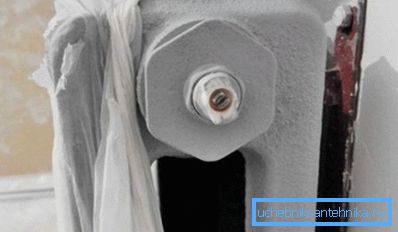
Mayevsky valve
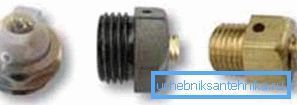
Note. Mayevsky's crane is called a type of valves with a valve, with which air is drained from radiators.
- In 1931, by order of the State Planning Committee, it was decided to use air taps on radiators to bleed air from them, and in 1933 the Leningrad engineer Ch.B. Mayevsky introduced a sealed valve designed by him that opened with a cross-shaped key. Now, as a rule, it is opened with a socket key or a screwdriver, but otherwise this device remains unchanged to this day.
- This design is a needle-type shut-off valve, where the stem is moved by a screw with a four-sided head, which has a slot, therefore, it is also regulated by a screwdriver. The hole where Mayevsky's faucet is screwed in for cast-iron radiators of 15 mm is similar to DU 15 or? - it is located in the upper part of the battery on the left or on the right, parallel to the thermal head or the upper supply pipe.
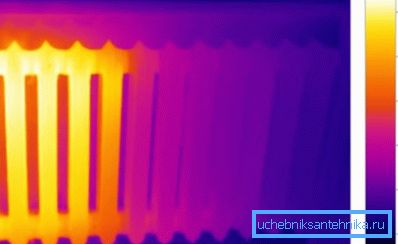
- You probably encountered such a situation when the radiator has different temperatures in different places (at one end it is hot, and at the other - cold) or you have all the batteries cold, and at the same time, the neighbors that are powered from the same riser - hot. And in one and in another case, the culprit of the situation is air plugs, which most often accumulate not in the pipes of the circuit, but in sections of radiators, not letting in water, that is, not allowing the coolant to circulate throughout the area of the device.
- Air usually accumulates at the bottom of the battery., where the circulation of the coolant is slow and in the old days the problem of its removal was solved with the help of an ordinary tap that was installed at the entrance or in someone's apartment - the air was released along with water, and the coolant merged with a huge amount.
And this was done even when the valve was no longer a novelty - the benefit of all the resources were ownerless and few people were interested in the energy consumption for the coolant, but now they learned how to count, and this device turned out to be very useful.
Note. It should be noted that such a valve is not a panacea, and if you bleed, and the battery remains barely warm, then the reason is that it is clogged and needs to be flushed.
Species
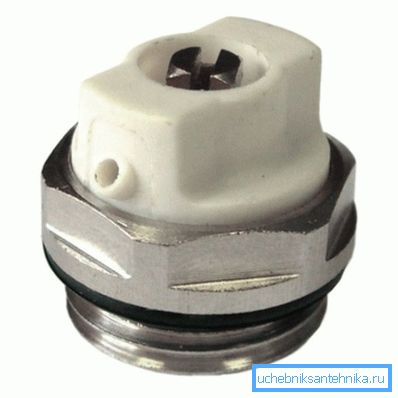
The most common worldwide for water heating systems is a manual valve, controlled by a socket wrench or a screwdriver - you can see its image in the top photo. The name (definition) comes from the method of control, but this does not detract from its merits - the mechanism is sufficiently reliable and, if properly installed, never creates problems and does not cause any complaints.

In some cases, the installation of an automatic Mayevsky crane is required, for example, where the maintenance of heaters is difficult or impossible at all - the staff may simply be absent.
But with such devices one should be very careful, as they independently bleed the air, along with which water comes out, so for residential premises, public buildings, shops and offices, this is hardly acceptable - it’s best to use a manual version of the mechanism, yes and its price is much less.
Device
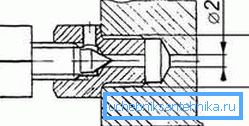
In appearance, the faucet or valve of Mayevsky is very similar to the most ordinary plug. Only with a slightly modified head, as there is a device for controlling the turnkey and screwdriver.
The entire air vent is made of two main parts - this is the case itself, which is screwed into the mounting threaded bore and valve, made in the form of a screw with a tapered end, which is clearly seen in the drawing above.
A calibrated hole is made in the inside of the case from the back side - when the screw is tightened, a cone enters and clogs the passage.
The principle of its operation is extremely clear from the mechanism: when unscrewing the tapered screw, the passage is released, the heat carrier presses the air and it passes through the sections, comes to the hole and goes down, of course, some water comes out, but even for an autonomous heating system it does not have absolutely no value.
The advantage of this device is that it can be controlled even by a teenager - the screw can be unscrewed very easily and after a few turns a characteristic hiss is already audible - the air is released.
In addition, the intake of hot water from the system through such a device is almost impossible, so the utilities serving you will be extremely happy to see the valve on your batteries.
Recommendation. If you decide to let the air out in the radiators, be sure to use a shallow bowl or at least a plate, as in any case some water will be spilled on the floor.
Air valve installation
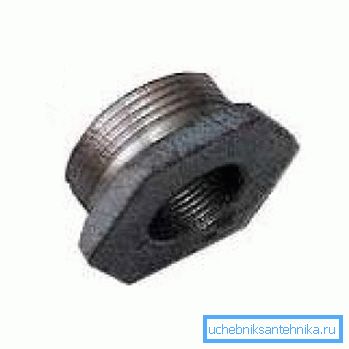
So, if you decide to install the Mayevsky crane for bimetallic radiators (cast iron or aluminum), then first of all, of course, you should go to the store and purchase it.
In addition, you will need a fum-tape (if you work with a cast-iron battery, you can use tow) and sanitary paste “Unipak”, which seals the threaded connection.
On bimetallic and aluminum radiators, there is already an inlet for the device, only a regular plug is screwed in there (in most cases, radiators are already equipped with a real crane), but for cast iron you will have to buy a futork with a threaded hole, as in the top photo.
Further, to install the device on the heater, the instruction requires that you shut off the shut-off valves (taps) on the supply and return pipes, and if there is no one, then you will have to drain water from the system or wait until the end of the heating season (at the end the water is drained).
Then, substituting a bowl or a deep plate, unscrew the plug or futorku if it is cast iron and clean the threaded hole from the debris that always accumulates there, even if the radiators were installed not so long ago.
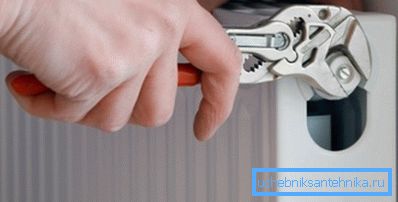
If it is cast iron, then twist a futorka with a hole, preloading it with tow and smearing Unipak paste, and tightening it must be very strong - usually use gas key No. 2 for this. After that, use Mayfsky's crane to tap the fum-tape, lubricate it with a paste and screw it into the hole. Open the valves of the valves and check the operation of the valve.
Conclusion
As you can see, the entire installation of the crane can be done by hand, without assistance, and there is nothing complicated about it. But, having established such a mechanism, you can correct the situation at any time of the year if air enters the heating system.